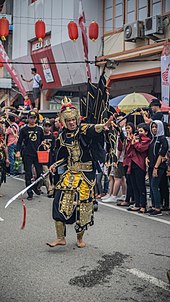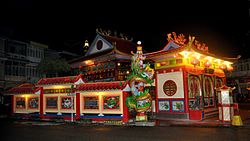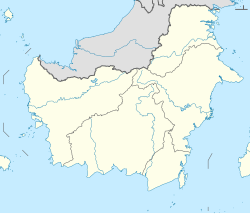|
Singkawang
Singkawang (Dayak Salako: Sakawokng), or San-Khew-Jong (Chinese: 山口洋; pinyin: Shānkǒuyáng; Pha̍k-fa-sṳ: Sân-gú-yòng), is a coastal city and port located in the province of West Kalimantan, on the island of Borneo in Indonesia. It is located at about 145 km north of Pontianak, the provincial capital, and is surrounded by the Pasi, Poteng, and Sakkok mountains. Singkawang is derived from the Salako language,[2] which refers to a very wide area of swamps (all swamps). In addition, the ancestors of the Hakka Chinese community in Sakawokng also named this area in Hakka as "San-Khew-Jong" (Mount-Mouth-Sea), which means "A city located at the foot of a mountain near the sea and has a river that flows up to the mouth of the river (estuary)." The city was created on 21 June 2001 by separation from Bengkayang Regency. It is bordered to the east and south by Bengkayang Regency, to the west by the South China Sea, and to the north by Sambas Regency. It covers an area of 504 km2 and had a population of 186,462 at the 2010 Census[3] and 235,064 at the 2020 Census;[4] the official estimate as at mid 2023 was 246,112 (comprising 125,788 males and 120,324 females).[1] HistorySingkawang ( in chinese : 山口洋 ) name came from one of chinese language ( Hakka language)The word "San" (山) which means Mountain and Forest, the word "Khew" (口) which means the mouth of the river, and the word "Jong" (洋) which means the sea. The miners and traders who came mostly from China, before they headed towards Monterado, first rested in Singkawang, while gold miners from Monterado often rested in Singkawang to remove their tiredness, while Singkawang also served as the transit point for the transportation of gold dust. At that time, they called Singkawang with the word Sakawokng (Salakko Dayak language), which means a very wide swampy swamp area located on the beach. Dayak Salako are part of the soldiers and intelligence of the Sultanate of Sambas which was given territorial territory in Binua Sarauntung Sakawokng. Basically the Salako Dayak tribe has long inhabited the Sakawokng area before it became a bustling trading area. The Hakka Chinese who came from South China, who were mostly farmers, traders, and gold miners at that time entered the Sakawokng area through small rivers in the Sado (Sedau) area. At first, the Singkawang area was still a vast wilderness filled with swamps. Due to its geographical location, the Hakka Chinese immigrants named this area in Hakka as "San Khew Jong" (山口洋). These three syllables really describe the geographical location of Singkawang which is surrounded by mountains and adjacent to the sea and has a river that flows from upstream to downstream and empties into the mouth of the river (estuary). Coincidentally or not, the name San Khew Jong given by the Hakka Chinese immigrants has the same sound and meaning as the name Sakawokng, which was first named by the Salako Dayak ancestors. This shows that there has been a well-established interaction since time immemorial between the Chinese Hakka community and the indigenous Dayak Salako Sakawokng, especially in terms of language and culture. Singkawang was previously used to be as the administrative centre of Sambas Regency under the status of Singkawang district. On 12 December 1981, Singkawang became administrative city within that regency. On 27 April 1999, when Bengkayang Regency was established, Singkawang became part of that regency, while the administrative centre of Sambas Regency was moved back to Sambas from the city on 15 July. The city was formed as an autonomous city on 21 June 2001 by separation from Bengkayang Regency. Administrative districtsPrior to decentralization in which time during Singkawang as an administrative city within Sambas Regency before it established as a independent city in 2001, the city had three administrative districts, Roban, Pasiran and Tujuhbelas. These three districts were previously part of undivided Singkawang district until 1981. In 2003, the districts later reorganized by splitting the Tujuhbelas district into three new districts (East Singkawang and North Singkawang, while Tujuhbelas district renamed as South Singkawang), while residual districts of Roban and Pasiran were renamed as Central Singkawang and West Singkawang, respectively. The city is divided into five administrative districts (kecamatan), listed below with their areas and their populations at the 2010 Census[3] and the 2020 Census,[4] together with the official estimates as at mid 2023.[1] The table also includes the number of urban villages (kelurahan) in each district, and its post codes.
Note: (a) including offshore island of Pulau Simping. ClimateSingkawang has a tropical rainforest climate (Af) with heavy to very heavy rainfall year-round.
DemographicsMost of the population are of Chinese descent (around 42% of whole population). The largest group of Chinese descent is Hakka people (locally called as "Hakka-nyin" who speak Guangdong-Hakka dialect). The other major group of Chinese descent is Chaozhou People which is better known as Teochew. The rest are Malay, Dayak, Javanese, and other ethnicities. The total population was 235,064 at the 2020 Census.[4] Religion in Singkawang (2022)[7] Islam (54.6%) Buddhism (32.2%) Roman catholic (7.46%) Protestantism (5.57%) Confucianism (0.64%) Hinduism (0.3%) Folk religion (0.1%)
The distribution of the religion practically follows the distribution of the ethnic groups; the largest groups are Islam followed by Buddhism, Catholic, Protestant and Confucianism.[7][8] FoodChinese food especially Hakka style dominates the food stalls or small restaurants, but Teochew style is also available. Minang style food can also be found here. Unique food like Rujak Ju Hie (鱿鱼炒; rojak with dried squid) is one of delicacies in Singkawang. Tofu (bean curd) Singkawang is famous in West Kalimantan, also Kembang Tahu (腐皮; silky smooth tofu with sugar gravy) is very popular in this city. Singkawang is also famous for its cakes. The variety of cakes is surprising and available from early morning till midnight. Choi Pan (菜粄:Steamed vegetable dumplings) is one of the many special traditional Chinese delicacies. Believed to be of Hakka origin, it consists mainly of fragrantly stir-fried yam bean wrapped in a slightly chewy translucent skin and is steamed to perfection.[9] There are also have several Malay food such as Bubur Paddas (Malay's spicy porridge), Pedak (fermented shrimp paste) and Nasi Lemak. Kopi tiam (咖啡店; local coffee shop) with strong bitter robusta coffee can be found every where. Peaceful and safe feeling for everyone makes Singkawang to be one of the cities with lively night. One may enjoy various food in Pasar Hongkong from porridge, kwetiau, fried rice, nasi lemak, rujak (fruit & vegetables salad), cakes coffee stall. And the prices of the food are surprisingly cheap. Local people enjoy the night with their friends discussing the local hottest issues, singing, or playing cards. ChinatownBesides being well known as the City of Thousands Temples, as there are many small and large temples in any part of the Singkawang region, Singkawang is also known as one of the Indonesian Chinatowns since the majority of the population is of Chinese descent, consisting of mostly Hakka and some other sub-group of Han Chinese. Theye reside in all areas in the city. They still practice their culture in any ceremony or official events, from weddings to funeral ceremonies. The culture is seen as the closest to the original tradition of Chinese people (mostly refers to Hakka), making Singkawang known as the Indonesian Chinatown. LanguagesBecause over 70% of the population of this city is of Chinese Indonesian descent[10], most people in this city speak Chinese (Hakka). Singkawang people use Indonesian as the primary language in conversation or trading and also use their own mother tongue. As Singkawang consists of three major ethnic groups, Chinese, Malays and Dayaks, the majority of Singkawang people use either Indonesian or Hakka Chinese for conversation. The Indonesian used in Singkawang commonly for daily conversation is not standard Indonesian, but has some Malay influence on vocabulary as Malay is the closest language to Indonesian and the Singkawang people have for years been accustomed to Malay. TransportationAs of today, there is no airport at Singkawang, and is instead served by Supadio International Airport. It is connected by road and can be reached by bus or taxi from Pontianak covering a distance of 150 km. It is also connected by road to Kuching in Malaysia via the Aruk/Biawak border and Sambas. A toll road to Pontianak is under consideration.[11] A new international airport, which will serve Singkawang and become an alternative for Pontianak airport, is under construction. It will be built in two phases, out of which the first phase is expected to be completed by the end of 2024.[12][13] Festivals
Around SingkawangPlaces of interest around the city are:
Mail order bride scandalThere have been allegations of human trafficking in Singkawang, based upon the town's mail order bride illegal business.[15] Most of the men who travel to Singkawang looking for young women to marry are from Taiwan, Mainland China, or Singapore. These men arrive and get in touch with brokers, these brokers then approach families with suitably aged daughters and generally offers these parents about 6 million rupiahs (about US$450) for each girl. It is most normal for a majority of these foreign clients to pay an amount exceedingly more than what is requested by the brokers and most payments are at an average of 30 million rupiahs (about US$2,250). Contracts are often drawn between the brokers and the clients. It is a fact that each contract includes a time period clause and most of these marriages are contractually bound for 2 to 4 years, some for even shorter periods of time. It is also common for these relationships to not be legally bound marriages. Indonesian police actively arrest the offender of mail order bride.[16] Sister cities
Notable people
Notes
References
External linksWikimedia Commons has media related to Singkawang.
|
||||||||||||||||||||||||||||||||||||||||||||||||||||||||||||||||||||||||||||||||||||||||||||||||||||||||||||||||||||||||||||||||||||||||||||||||||||||||||||||||||||||||||||||||||||||||||||||||||||||||||||||||||||||||||||||||||||||||||||||||||||||||||||||||||||||||||||||||||||||||||||||||||||||||||||||||||||||||||








